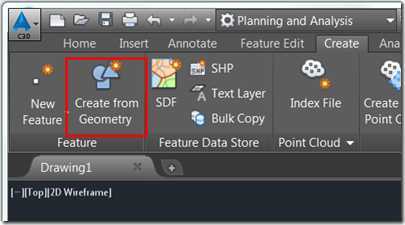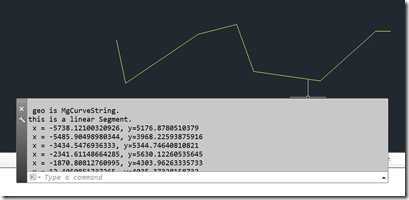通过Map 3D API读取线状要素的节点坐标
2020-12-13 04:12
标签:des style blog http color 使用 By Daniel Du 在Map 3D中可以使用Create from Geometry命令把AutoCAD实体转换成Map 3D中的FDO要素,比如可以把AutoCAD的polyline转换成FDO线状要素。 对于只包含直线的AutoCAD polyline,在转成FDO要素后,将是一个MgCurveString对象,并且只包含一个LinearSegment。 如果AutoCAD polyine中包含弧Arc, 那转换出来的FDO要素对象,将是一个包含多个segment的MgCurveString对象。其中有Arc Segment也有linear segment。 下面是对这样的线状要素读取坐标点的代码: 通过Map 3D API读取线状要素的节点坐标,搜素材,soscw.com 通过Map 3D API读取线状要素的节点坐标 标签:des style blog http color 使用 原文地址:http://www.cnblogs.com/junqilian/p/3836094.html


using System;
using Autodesk.AutoCAD.Runtime;
using Autodesk.AutoCAD.ApplicationServices;
using Autodesk.AutoCAD.DatabaseServices;
using Autodesk.AutoCAD.Geometry;
using Autodesk.AutoCAD.EditorInput;
using Autodesk.Gis.Map.Platform.Interop;
using Autodesk.Gis.Map.Platform;
using OSGeo.MapGuide;
// This line is not mandatory, but improves loading performances
[assembly: CommandClass(typeof(GetFeatureType.MyCommands))]
namespace GetFeatureType
{
public class MyCommands
{
// Modal Command with localized name
[CommandMethod("getPolylineCoordinates")]
public void MyCommand() // This method can have any name
{
Editor ed = Autodesk.AutoCAD.ApplicationServices.Application
.DocumentManager.MdiActiveDocument.Editor;
Transaction trans = Autodesk.AutoCAD.ApplicationServices.Application
.DocumentManager.MdiActiveDocument.Database.TransactionManager
.StartTransaction();
using (trans)
{
// Get the Map Object
AcMapMap currentMap = AcMapMap.GetCurrentMap();
// Prompt user to Select Feature in Map
PromptSelectionOptions psop = new PromptSelectionOptions();
psop.MessageForAdding = "Select the FDO Feature in Map 3D to read Data : ";
psop.SingleOnly = true;
PromptSelectionResult psResult = ed.GetSelection(psop);
if (psResult.Status == PromptStatus.OK)
{
SelectionSet selSet = psResult.Value;
// Get Map Selectionset from AutoCAD SelectionSet
MgSelectionBase mapSelBase = AcMapFeatureEntityService
.GetSelection(selSet);
AcMapLayer mapLayer = AcMapFeatureEntityService
.GetLayer(psResult.Value[0].ObjectId);
//Get the ID of the selected Parcel
MgFeatureReader ftrRdr = mapSelBase.GetSelectedFeatures(
mapLayer, mapLayer.FeatureClassName, false);
while (ftrRdr.ReadNext())
{
MgClassDefinition cd = ftrRdr.GetClassDefinition();
//the geomety property name maybe different for your
//data source
MgByteReader byteRdr = ftrRdr.GetGeometry("Geometry");
MgAgfReaderWriter wtr = new MgAgfReaderWriter();
MgGeometry geom = wtr.Read(byteRdr);
if (geom is OSGeo.MapGuide.MgCurveString)
{
var cs = geom as MgCurveString;
ed.WriteMessage("\n geo is MgCurveString.");
for (int i = 0, segmentCount = cs.Count; i {
var seg = cs.GetSegment(i);
if (seg is MgArcSegment)
{
ed.WriteMessage("\nthis is an Arc Segment.");
var arcSeg = seg as MgArcSegment;
string msg = string.Format(
"\nstart point: x= {0}, y={1}",
arcSeg.StartCoordinate.X,
arcSeg.StartCoordinate.Y);
ed.WriteMessage(msg);
msg = string.Format(
"\ncontrol point x= {0}, y={1}",
arcSeg.ControlCoordinate.X,
arcSeg.ControlCoordinate.Y);
ed.WriteMessage(msg);
msg = string.Format(
"\nend point: x= {0}, y={1}",
arcSeg.EndCoordinate.X,
arcSeg.EndCoordinate.Y);
ed.WriteMessage(msg);
}
if (seg is MgLinearSegment)
{
ed.WriteMessage("\nthis is a linear Segment.");
var linearSeg = seg as MgLinearSegment;
var interator = linearSeg.GetCoordinates();
while (interator.MoveNext())
{
var x = interator.GetCurrent().X;
var y = interator.GetCurrent().Y;
ed.WriteMessage(string.Format(
"\n x = {0}, y={1} ", x, y));
}
}
}
}
if (geom is OSGeo.MapGuide.MgLineString)
{
var ls = geom as MgLineString;
var interator = ls.GetCoordinates();
while (interator.MoveNext())
{
var x = interator.GetCurrent().X;
var y = interator.GetCurrent().Y;
ed.WriteMessage(string.Format(
"\n x = {0}, y={1} ", x, y));
}
}
}
}
trans.Commit();
}
}
}
}